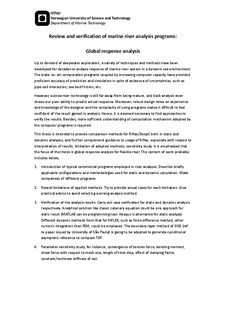Review and verification of marine riser analysis programs
Master thesis

View/
Date
2010Metadata
Show full item recordCollections
- Institutt for marin teknikk [3397]
Abstract
Availability of diverse computation packages for marine risers eases structural assessment and reduces cost for experiments and design. Successful industrial applications have proven that time domain analysis programs provide effective solution for global response analysis. Nevertheless, good command of methodologies adopted by popular programs and awareness of limitations corresponding to different techniques are imperative, if the analyst intends to make proper use of the computerized tools. Frequently it remains uncertain to know the correctness of analyze results due to lack of comparison approach and proficient understanding of structural behavior, even if the analysis is conducted as instructed by software supplier.
This thesis makes a review of the most popular computation programs. Comparison work is done to indicate their common features and particular characteristics. Further, a careful examination lists limitations and uncertainties of the applied analysis technologies and gives explanation to the source of the problems. General guidance is provided for how to avoid these unsolved imperfections.
The core part of this thesis is to make verification of Riflex accounting for global analysis of catenary risers. Static validation is based on Faltisen’s catenary equations. MATLAB is employed to program a simple routine to calculate static configuration of SCR and LWR. Dynamic validation refers to a boundary layer value method proposed by J.A.P. Aranha. A semi-independent comparison is performed to verify dynamic bending moment at TDA.
Last, parametric study is carried out to investigate stability of numeric integration. The effects of time step setting and mesh density are studied. Besides, to better understand structural behavior of catenary risers, effects of water depth, riser wall thickness and arc length are tested on the basis of previous work last semester.